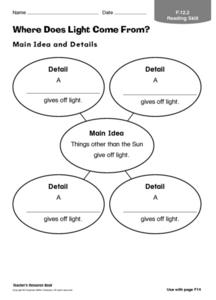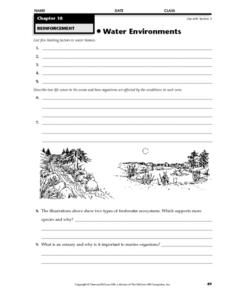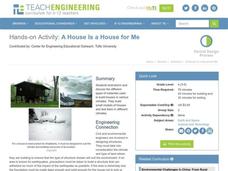Curated OER
What Are Kinetic and Potential Energy?
In this energy worksheet, students will brainstorm examples of potential energy and kinetic energy and list them in their appropriate categories.
Curated OER
What Are Earth's Ecosystems?
In this ecosystems worksheet, students will brainstorm facts that relate to 6 different habitats found on the earth: tundra, taiga, grassland, temperate forest, tropical rain forest, and desert.
Curated OER
What Relationship Do Species Have?
In this species relationships worksheet, students will brainstorm animals or plants that are examples of mutualism, commensalism, and parasitism.
Curated OER
Where Does Heat Come From?
In this heat worksheet, students will brainstorm objects that give off heat. Then students will complete the statement "Heat can make things __________."
Curated OER
Where Does Light Come From?
In this light worksheet, students will brainstorm 4 different objects that give off light, other than the sun. Students will put their ideas into a graphic organizer.
Curated OER
How Do Species Change?
In this species changing worksheet, students will brainstorm problems that species face in their habitats. Then students will write in the solution for each problem they wrote down in this graphic organizer worksheet.
Curated OER
How Do Parts Help Classify Plants?
In this classifying plants worksheet, students will brainstorm different types of roots, stems, and leaves and determine how those differences help scientist classify plants into different categories.
Curated OER
Animal Adaptations
In this animal adaptations worksheet, students will complete a graphic organizer by brainstorming 3 animals and an adaptation that animal has that helps it to survive.
Curated OER
What Animals Are Mammals And Birds?
In this classification worksheet, students will brainstorm animals and list them on the graphic organizer as either a mammal or a bird.
Curated OER
Factors That Affect Populations
In this population worksheet, students will brainstorm 6 different factors that can affect an organism's population. Students will write down their ideas in this graphic organizer.
Curated OER
What is a Food Web?
In this food web worksheet, students will brainstorm organisms and classify them as either a consumer, producer, or decomposer. Students will write the organisms under the correct category in this graphic organizer worksheet.
Curated OER
Water Environments
In this water environments worksheet, students will brainstorm limiting factors in water biomes, describe the two life zones in the ocean, and compare two types of freshwater ecosystems. This worksheet has 9 short answer questions.
Curated OER
Natural Resources
In this natural resources worksheet, students will brainstorm 3 examples of renewable resources and 3 examples of nonrenewable resources. This worksheet is a graphic organizer.
Curated OER
Natural Resources
In this natural resources worksheet, students will brainstorm natural resources, how people change the Earth, and how people can save the natural resources. This worksheet is a graphic organizer.
Curated OER
What Are Nonliving Parts of Ecosystems?
In this ecosystem worksheet, students brainstorm the nonliving things found in a desert ecosystem and a polar ecosystem. This worksheet is a graphic organizer.
Curated OER
Parts of Ecosystems
In this ecosystem worksheet, students brainstorm and write down as many living and nonliving things found in an ecosystem. This worksheet is a graphic organizer.
Curated OER
What Are Solutions?
In this solutions worksheet, students brainstorm different types of solutions and an example of each type of solution. This worksheet is a graphic organizer.
Curated OER
How Do We Use Water?
In this water use worksheet, students brainstorm different ways people use water and then complete 3 fill in the blank statements about how people can keep water clean. This worksheet is a graphic organizer.
Curated OER
Energy Efficiency: It really IS important!
Students compare the energy needed to produce new products versus recycling. In this physics lesson, students brainstorm ways to save energy. They create a presentation about the correlation between conserving energy and energy costs.
Curated OER
Cloning Around
Review concepts of cloning and genetic engineering and participate in a round-table discussion based on the ethics and potential of cloning with your class. Each learner then writes a formal essay on the topic, stemming from the debate.
Curated OER
Save an Endangered Species
Have your young learners work in pairs to find and research an endangered species. They use research to develop ideas about saving their animal from extinction. Pairs develop a three-dimensional model of the animal's habitat. Then, they...
Curated OER
The Debate Over Stem Cell Research
Students complete a variety of activities as they examine the ethical issues behind stem cell research and cloning. They make their own ethical decisions on both subjects.
Curated OER
Pet Rescue
Learners, in teams, follow the process of design, including the stages of investigation, creation, and reflection, as they devise a way to help "save" a (simulated) pet who is trapped in a pipe.
Curated OER
A House is a House for Me
Young scholars evaluate the impact climates have on the building of structures. They research the different types of materials used to build houses in various climates and build small models of houses which are tested against different...

























